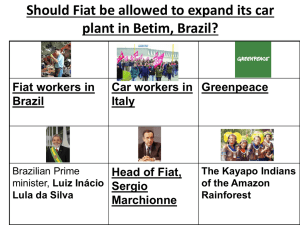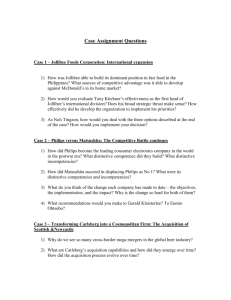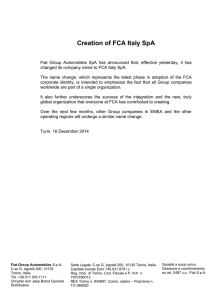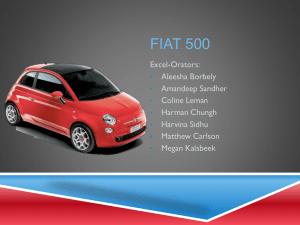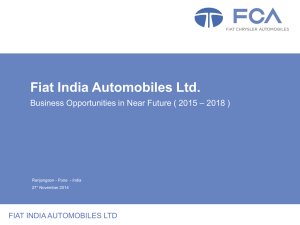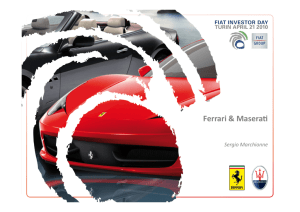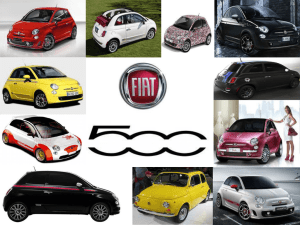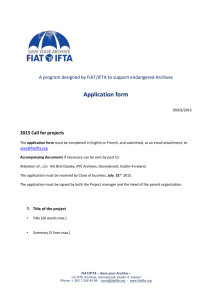“Revamping Fiat's Business Strategy for the American Consumer
advertisement
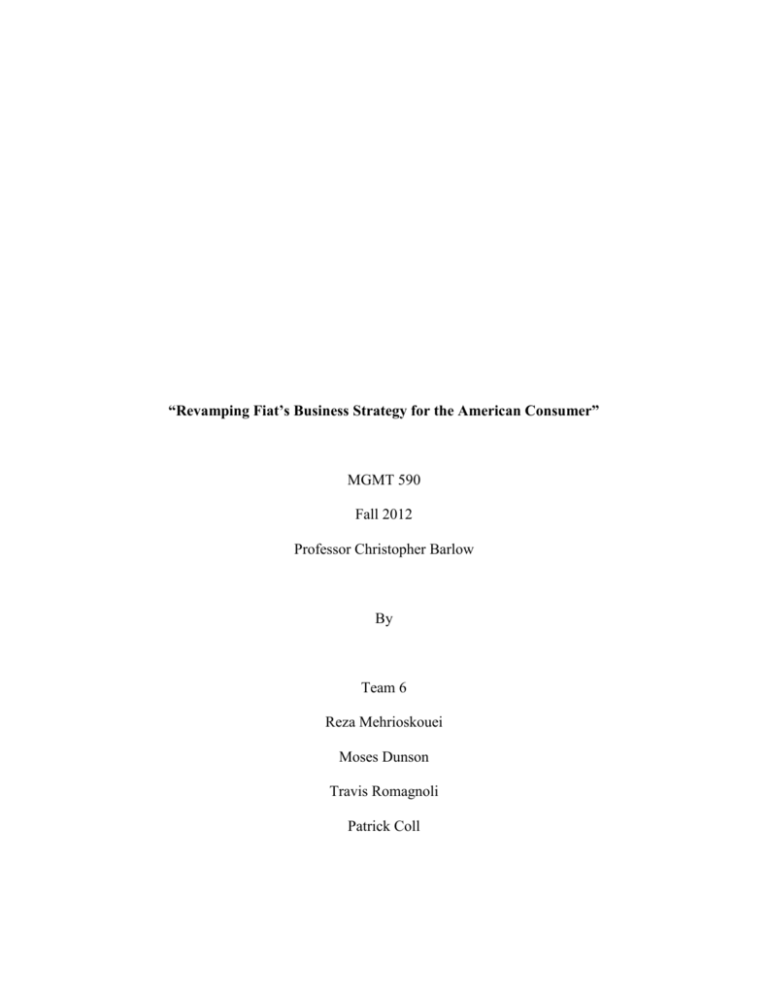
“Revamping Fiat’s Business Strategy for the American Consumer” MGMT 590 Fall 2012 Professor Christopher Barlow By Team 6 Reza Mehrioskouei Moses Dunson Travis Romagnoli Patrick Coll COMPANY OVERVIEW Founded in 1899, Italian based Fiat automotive group is the largest automaker in Italy and as of 2009 ranked overall ninth largest worldwide. Fiat success revolves on providing fuel efficient small sized vehicles to its market, locally and internationally. Its international prowess can be measured by its domination in the Brazilian market. Using flex-fuel technology, Fiat adopted a standard and localized strategy to develop vehicles that used alternative fuel solutions to compete against the rise of standard gasoline prices. Fiat sold 665,514 vehicles in Brazil in 2008, allowing Fiat to continue as the market leader seven years in a row. Gaining international success Fiat acquired American automaker, Chrysler LLC, on January 20, 2009. The terms of the new agreement would involve Fiat taking 25% on Chrysler earnings and access to its North American distribution network in exchange for providing Chrysler technology and platforms to build fuel-efficient vehicles in the US and access to Fiat’s global distribution. In 2007, within three weeks of its European launch of the mini Fiat 500 the entire year's production of 58,000 had been sold out. Fiat sought to capitalize on this by spearheading expansion into the U.S. market by choosing to launch its successful Fiat 500 line as the only available model. CURRENT STRATEGY Fiat met several roadblocks introducing the Fiat 500 with its standardization strategy. Their standardization strategy was reflected upon consumers that personify an etic perspective, representing the commonalities across cultures. Their integration failed to satisfy consumer behavior by missing out on American consumer preferences. The company did not develop and refine appropriate expansion plans in close interaction with its local environment; instead they should have been focusing on a narrower range of preferences and feedback, lowering the risk of being blocked from the local consumer culture. Their adoption of a standardized strategy premises that markets across the world are homogeneous; this suggests that consumer behavior in these segments share the same outlooks, preferences, aspirations, and values. This approach was thought to benefit from economies of scale by not incurring time or expense to develop alternate strategies for different cultures. Advocating a global plan is great in principle however practicing this strategy proves not to be beneficial. Its failure is due to the fact that consumers in different countries have different customs and attitudes resulting in them not using the same products the same way or not responding to global marketing tactics. INDUSTRY In the wake of international economic crises, the automotive industry has suffered its fair share of losses. From bailouts to bankruptcies followed by vast restructurings, the aftermath poses the survivors in the industry against one another to compete for its remaining yet frugal potential consumers. Aside from brand name differences, like competing automobiles have relatively little difference in their attributes making cost a key determinant in the consumer decision making process. With many underlying factors, the car industry has much to contend with as these are causing the contraction in demand for its automobiles. The automotive industry will not be without its difficulties in gaining the revenue that it once enjoyed. Consumers will play a significant role in reshaping and ushering the automotive industry along as it seeks to reestablish itself. There will, however, be many obstacles for the industry to overcome in light of recent economic trends. Due to the poor economy over the last few years, consumer preferences have grown to be more cost sensitive. With automotive MSRPs readily available via the internet and other sources, consumers are looking to capture the best deal possible which significantly decreases the industry's revenue. In addition to this, consumers are looking for smaller and more economic vehicles. Rising fuel prices coupled with the reduced disposable income of most consumers, makes these vehicles more attractive. Because of these trends, there is significantly more automobile production than there is demand when compared to these figures prior to 2008. Strategies to regain and grow its customer base only address one area of concern for the industry. As it is typical for certain functions to be outsourced in the automotive industry, it is subject to the outcomes of those industries that provide important inputs. The economic crises have left very few industries unaffected; raw material and commodities suppliers are experiencing their own hardships with many expenses being transferred to auto manufacturers. This significantly increases industry operating costs which increases automotive prices for the end customer. This is one of many factors that reduce the confidence in automobile revenue forecasts. Many of the industry leaders are international brands. This exposes them to regional instabilities such as local economy fluctuations and labor union negotiations which both have a direct affect on operating costs. In short, it is difficult to sell a vehicle to customers for unreasonably inflated prices. Environmentally safe initiatives have had their affect on the less than stellar rebound of the automotive industry. Consumer preferences have changed in response to these initiatives. This is apparent with consumers paying a premium price for environmentally safely manufactured products over comparable products that are not. The trend of "going green" has grown with increased importance as international and federal laws have begun to steer the industry toward more fuel efficient cars. In addition, some environmentally conscious consumers have opted for alternative transportation such as public transit as they see this as a responsible thing to do. This creates an exit for more potential consumers which further increase the competitiveness within the automotive industry. With so many existing external influences of the industry, competition is extremely high. Many of these factors have changed because of the economic crises; global awareness, and economy evolution, automotive manufacturers will have to reposition themselves in order to survive the industry’s reformulation secondary to economic stabilization period. SWOT ANALYSIS: Strengths Fiat has a history in the United States going as far back as 1908 with a plant in Poughkeepsie, NY. Fiat returned to the United States in 2009 after purchasing 25% of Chrysler. As of July 2012, Fiat managed to increase its share of Chrysler to 61.8%, thus giving Fiat a major presence in the United States. Despite slow sales of the Fiat 500, Fiat has been profitable in the United States Ninth largest car manufactured in the world (and this doesn’t include Chrysler). With Fiat reestablishing a presence in North America, they bring a reputation of quality – as Fiat has won European car of the year 12 times in the last 40 years. More than any other manufacturer. Fiat has a large diversity of products ranging from economy vehicles to top of the line sports cars. Weaknesses Fiat left the American market in 1983 and wouldn’t return for 25 years with a reputation in America for poor quality cars. This is a challenge Fiat has to overcome as they have returned to the United States. Fiat 500 sales in the United States have been weaker than expected. Fiat’s smaller cars that offer high gas mileage tend to have much more appeal in European markets than American markets. Although Fiat’s stake in Chrysler has promising future possibilities, Chrysler is currently going through a bankruptcy restructuring that is making things difficult for Fiat in the mean time. Opportunities As the US economy begins to recover from the worst recession since the Great Depression, Fiat’s sales will likely increase in American dramatically. Given the high price of gasoline in the United States, more economical vehicles are making more sense for a larger percentage of the American public. This could lead to better sales for the Fiat 500 that has struggled in the United States. In general, American travel by automobile far more than people in Europe do. There is far less access to public transportation and cross country travel by train – making car ownership vital to most Americans. If Fiat can continue to make inroads in the United States, this could help the company overcome difficulties in the European economy. Threats Gas prices in the United States. The current price of gasoline in the United States has been at record highs making more fuel economy vehicles attractive to more Americans. If the price of gasoline were to start coming down, the demand for cars with high gas mileage would lessen. This would hurt sales of the Fiat 500 in America. The state of the European economy. It has been in crisis dealing with Greece and the impact of the high value of the Euro. This has made the price of imports very expensive for American companies. This could make it difficult for Fiat to become a major player in the American economy. Other American companies that offer fuel efficient vehicles. Americans have a large sense of patriotism and prefer to buy American products when possible. Given recent news that Fiat will be producing more its American cars in Italy, this could turn off American consumers. FINANCES (http://www.yahoo.com) Stock price: 5.48 (10/1/12) Fiat SPA had a stock split in January of 2011 where Fiat Industrial split from the Fiat Automotive division. Since the split, Fiat SPA stock (automotive division) continued to lose value despite a rise in the major stock indexes (see below Yahoo! chart). Key Statistics Valuation Measures Market Cap (intraday)5: Enterprise Value (Sep 27, 2012)3: 6.78B 17.73B Trailing P/E (ttm, intraday): 25.71 Forward P/E (fye Dec 31, 2013)1: PEG Ratio (5 yr expected)1: 5.03 -0.35 Price/Sales (ttm): 0.07 Price/Book (mrq): 0.59 Enterprise Value/Revenue (ttm) 3: 0.17 Enterprise Value/EBITDA (ttm) 6: 2.05 Financial Highlights Fiscal Year Ends: Dec 31 Most Recent Quarter (mrq): Jun 30, 2012 Profitability Profit Margin (ttm): 0.26% Operating Margin (ttm): 4.38% Management Effectiveness Return on Assets (ttm): 2.65% Return on Equity (ttm): 8.95% Income Statement Revenue (ttm): 101.89B Revenue Per Share (ttm): 83.81 Qtrly Revenue Growth (yoy): 63.60% Gross Profit (ttm): N/A EBITDA (ttm)6: 8.63B Net Income Avl to Common (ttm): 263.31M Diluted EPS (ttm): 0.22 Qtrly Earnings Growth (yoy): -92.10% Balance Sheet Total Cash (mrq): Total Cash Per Share (mrq): 25.90B 21.30 Total Debt (mrq): 36.84B Total Debt/Equity (mrq): 221.10 (as a percentage, so 2:1, D:E) Current Ratio (mrq): 1.51 (see below) Book Value Per Share (mrq): 9.72 The current ratio is a measure of the firm’s liquidity. Above 1.5 is an acceptable range for this ratio. Cash Flow Statement Operating Cash Flow (ttm): 7.76B Levered Free Cash Flow (ttm): -1.62B See Key Statistics Help for definitions of terms used. Abbreviation Guide: K = Thousands; M = Millions; B = Billions mrq = Most Recent Quarter (as of Jun 30, 2012) ttm = Trailing Twelve Months (as of Jun 30, 2012) yoy = Year Over Year (as of Jun 30, 2012) lfy = Last Fiscal Year (as of Dec 31, 2011) fye = Fiscal Year Ending 1 Data provided by Thomson Reuters 2 Data provided by EDGAR Online 3 Data derived from multiple sources or calculated by Yahoo! Finance 4 Data provided by Morningstar, Inc. PROPOSED STRATEGY Fiat partnered with Chrysler to achieve their mission of geographic diversification, and claim that by doing so they have realized economies of scale, increased production volumes per platform, and a full range of vehicles by combining Fiat’s small car segment with Chrysler’s mid and full-size segments (http://www.fiatspa.com/en-US/Pages/Home.aspx). However, the company’s re-entry into the US small car market has not achieved the expectations. Fiat’s brand awareness in the US is a likely contributor to low sales. Fiat understands the business of small cars, but it needs a new strategy to increase market share in the US. One way to do this is by being “American”. The US does not have its own “small car”. All the small cars are imports. Fiat can be the first to claim the mantel of the US small car by leveraging its relationship with Chrysler, an American mainstay in the US car industry. No other “small car” company has the ability to become “American” like Fiat. In order to do this, the company needs to convince the public that it is here to stay this time around, to assimilate into the American culture, and to show that it is committed to the success of the nation. In essence, they need to sell national pride. There is no reason to reinvent the wheel on small car technology and overspend on research and development. The Fiat 500 is good enough. Fiat could better spend that money by campaigning to become “American”. The Fiat 500 is known for its style. Now it has the opportunity to promote its “American” style. Fiat-Mopar Strategy Fiat and Chrysler Marriage As previously mentioned, Fiat SPA has performed marginally in the OTC stock market. However, as of November 23, 2012, Morningstar has the company rated at 5-stars (http://quote.morningstar.com/stock/s.aspx?t=FIATY). This high rating is at least partly attributed to the leadership provided by CEO Sergio Marchionne, who took a risk on Chrysler (Auburn Hills, MI) in 2009 that has paid off to the point where the question has shifted from, “will Chrysler survive?” to, “how much market share can they get?” (http://www.cbsnews.com/video/watch/?id=7403188n, CBS). At risk was 300,000 jobs in the company and it’s supply chain (CBS). In an interview on 60 Minutes that aired March 25, 2012, Marchionne described the fear that existed in Chrysler, which he said was a result of employees not having (or feeling like they had) an influence on company processes and outcomes (CBS). Marchionne immediately addressed the bureaucracy within the company and found 26 new “Leaders”, who were all buried in non-leadership jobs (CBS). Chrysler’s dramatic recovery was highlighted by their 2011 profit of $183 million dollars and their early (six years) pay back of a 6 Billion dollar, 19.7% interest Treasury, “Bailout” loan (CBS). The 6 Billion dollars was used to modernize Chrysler plants and to maintain and revitalize the workforce (CBS). As previously described, Marchionne integrated Fiat and Chrysler operations to develop a complete product (car) portfolio. As time passes, and if Chrysler continues its success story, Marchionne might be mentioned in the same breath as other 10Xer’s “or other great leaders” described in the book, “Great by Choice” (Collins). In particular, he displays the trait that the book describes as “Productive Paranoia”, where a 10xer is highly aware of threats and industry changes even when things are going well (Collins). His greatest fear for Chrysler is that they will slip on execution, “get something wrong – big…screw up on a car, where it won’t sell” in an industry where the room for error could be a small such as missing the market on one car (CBS). Fiat’s decision to produce an Electric car (http://www.caranddriver.com/news/fiat-500bev-concept-car-news) could prove to be successful, but it is possible that they are behind the curve in this market, and that the large dollar investments into this technology could be wasted and result in no significant market share gains. With increasing fuel costs, a growing trend has developed among car buyers for fuel efficiency, with US car manufacturers investing heavily in hybrid gas/electric vehicle technology. Fiat is not behind the curve in regard to fuel efficiency technology. It is currently the largest seller of compressed natural gas (CNG) in Europe. Chrysler’s Ram brand has just started production of CNG-powered heavy-duty pickups. In addition, CNG use will cut fuel energy cost and decrease the US dependence on foreign oil imports. Although it’s a controversial technique for hydrocarbon extraction, hydraulic fracturing in the US will exploit massive deposits of natural gas reducing the demand for energy importing. This fuel source will serve as an alternative to traditional gas engines and a competitor to the gas/electric hybrid vehicles. Currently the infrastructure is not set up in the US to capitalize on this resource so research and development for most companies is, at best, in the exploratory phase. Fiat-Chrysler’s future share of the US car market could hinge on its success specifically in the growing small-car market segment. The Wall Street Journal “Auto Sales Market Data Center” estimates that the small-car market segment is 2.1 MM in 2012 (http://online.wsj.com/mdc/public/page/2_3022-autosales.html, WSJ). This is up 25% from 2011 and is by far the fastest growing segment in the US car market (WSJ). Segment totals as of Thursday November 1, 2012: Auto Segment % Chg from YTD 2011 Cars 18.9 Midsize 19.9 Small 24.9 Luxury 10.1 Large -87.9 Light-duty trucks 8.8 Pickup 7.9 Cross-over 8.6 Minivan 16.2 Midsize SUV 9.7 Large SUV -9.1 Small SUV 15.7 Luxury SUV 3.6 Total SUV/Cross-over 7.8 Total SUV 5.9 Total Cross-over 8.6 Source: www.motorintelligence.com The 2013 edition Dodge Dart (previous production run from 1960-1976, http://en.wikipedia.org/wiki/Dodge_Dart) was the first small-car offspring resulting from the marriage between Fiat and Chrysler. However, the Fiat 500 is the “cool” older stepbrother that needs to be given a little more time and attention so that he can reach his potential in the US. Copied from http://www.mopar.com/ Mopar has been the long-standing provider of genuine auto-parts, service and customer care (vehicle protection) for the Chrysler family vehicles (http://www.chrysler.com/en/, Chrysler). The Mopar brand is currently celebrating its 75th anniversary (http://www.mopar.com/, Mopar). MOPAR provides performance and stylistic upgrades to most Chrysler family vehicles including the Fiat 500 model (Mopar). Mopar also produces special edition, high-performance vehicles as limited releases (Mopar). Some of the most recent special edition vehicles include the Mopar ’10 Challenger R/T and the Mopar ’11 Charger R/T (http://www.mopar.com/mopar/). Mopar is a symbol of American heritage and quality. The Mopar brand is well known among car enthusiasts and fanatics of Chrysler, Dodge, and Jeep vehicles. However, it lacks visibility in the general consumer population. Previously, we proposed that Fiat leverage its relationship with Chrysler to produce a small car that Americans would be able to relate to. More specifically, we propose that FiatChrysler leverage the Mopar brand to produce a high performance small car with a link to American heritage to rival the Mini Cooper S in the market. The first step to achieving this goal will be to reintroduce the “Mopar” to America by increasing Mopar brand awareness and recognition through new advertising and sponsorship campaigns. Mopar’s 75th anniversary celebration is a perfect opportunity to promote the brand. It will be key to link the Mopar brand with Chrysler’s American performance, style, and heritage. The next step will be to link the Mopar brand with Fiat car model by creating a limited production Mopar Fiat special edition model to join the ’10 Challenger and ’11 Charger (see http://www.mopar.com/mopar/). This model would be ready for release by 2014 and could be called the, “Mopar ’14 Fiat”. The final step will be to introduce the Mopar Standard Fiat, or Mopar S, as the replacement to the Abarth in the Fiat line. The Arbarth is currently the “performance” model in the Fiat line, but still lacks the power and performance of the Mini S. Furthermore, Carlo Abarth, although a renowned automobile designer in Italy (http://en.wikipedia.org/wiki/Carlo_Abarth) is not sufficiently recognized in the US in order to be symbolic of high-performance vehicles. The Mopar S will essentially be the “Abarth” platform, but it will available with Mopar performance and style parts. These additions will be both interior and exterior, and would include a cold air intake system as well as suspension upgrades using strut braces (see Mopar). Cold air intake systems increase a vehicle’s horsepower, and the effect is more noticeable in smaller cars (http://www.ehow.com/way_5588555_do-air-intakes-increase-horsepower_.html). The Abarth model has 160 horsepower compared to the 181 horsepower of the Mini Cooper S. The Mopar upgrades would bring the new Mopar S model to a performance level equal to that of the Mini Cooper S. And with performance being equal, we believe that the Mopar S could beat the Mini Cooper S in the high-performance small car market, because it now has an advantage, the “American” factor, as a result of Mopar branding. The hope would be that a “win” in this area would produce a trickledown effect to other models in the newly revised Fiat line. The Mopar branding and the new Mopar S production represent low cost strategies. The process would involve using existing Mopar infrastructure and parts for current Fiat models (http://www.mopar.com/fiat/500/2013/). So, there are no big production costs for making the change from the Abarth to the Mopar S (i.e. no new factory and no new processes). This strategy leverages the Mopar brand that already exists. The simplicity and low cost of this plan makes it an attractive low-risk strategy or an option to a full-fledged high-risk strategy. How to test the plan The success of this plan will initially and heavily rely on the ability to combine Fiat’s Italian design with the American popularity of Mopar. That combination will be enhanced with the incorporation of customer feedback. We intend to solicit customer feedback in several ways to help improve upon the strategy. A vehicle customization application on the Fiat website that allows for customers to design their own version of the Abarth with Mopar equipment will be developed. Customers will be able to upgrade any of the Fiat vehicles offered in the US. The data from this application will be analyzed instantaneously and used to make adjustments to the strategy to make. Ultimately, the popularity of the many attributes will influence design of a stock Fiat 500 Mopar that will be marketed. This will also help to determine if the Mopar strategy is a worthwhile strategy to continue with. In addition, this form of testing will serve as an input during quality function development as Fiat designers seek to extend the life of the brand through incorporating the desires of the US market into the Italian design. Fiat’s reentrance into the US market is still new so the assurance of its longevity is fragile. Word of mouth has the potential to make or break this strategy and Fiat’s future in the US market. Beta testing will be instrumental for forecasting the viability of Fiat’s position in the US market. Featuring the vehicle in car shows will be instrumental in gaining popularity for the brand as this will introduce potential customers to the unique Italian design enhanced with Mopar special edition packages. Promoting a Fiat test drive campaign will also work well for allowing users to get a feel for the vehicles drivability as most Americans at best are only familiar with the physical attributes of the Fiat. Active listening to bloggers will help to make sure Fiat has addressed major issues. Ultimately, commercialization will be the greatest generator of interest for the vehicle in the US. Without it, implementing the above mentioned testing strategies will not produce the customer volume necessary to make informed predictions. In an effort to save on production and marketing costs however, market factor testing is warranted to serve as an indicator of the potential interest of the Fiat brand. Flooding the airwaves of select markets with celebrity filled commercials and monitoring that market’s response will help predict success. If the results from the testing show are promising, a full scale national advertising campaign should be encouraged. Strategy Risk There are many strategic uncertainties Fiat faces in the United States market. First, there are significant macroeconomic factors that are beyond Fiat’s control. Since the great recession of 2008 and 2009, the US and world economies have recovered very slowly. GDP growth in the United States has averaged around 2% over the past few years, well below historical norms for a recovery. Furthermore, the US debt situation has grown exponentially in recent years to levels around 100% of GDP. This has brought about the so-called “fiscal cliff” situation where lawmakers have been forced to consider previously unthinkable large tax increases and spending cuts. Leading economists fear that the impending "fiscal cliff" could lead to another recession in 2013. http://en.wikipedia.org/wiki/Economy_of_the_United_States In addition, the European and Italian economies are in an even more precarious position. First, there is the trickledown effect of the US economic struggles, given the billions of dollars traded annually between the US and the European Union which includes Italy. Second, debt levels in many European countries are in even worse shape than US debt levels – especially in Greece, a fellow EU member. This required other EU nations such as Italy to “bail out” Greece to avoid its economic collapse. Those are dollars that could otherwise be spend to prop up the rest of the EU, including Italy, which could use those dollars themselves. Since Fiat in an Italian company hoping to be successful in the United States, the aforementioned macroeconomic problems are reasons for major concern moving forward. (http://en.wikipedia.org/wiki/Economy_of_the_European_Union) Another reason for concern is the price of gas. Gas has consistently been very high in Europe and Italy making small, fuel efficient cars very desirable. However, in recent decades gas prices in the United States have been at relatively affordable rates for the average American consumer. In the 2000’s, this began to change after 9/11, the wars in Iraq and Afghanistan, the worldwide fiscal crisis and the shady dealings of OPEC. Gas prices reached $4 a gallon in some areas of the United States that became very unaffordable for the average US consumer, especially considering the economic slowdown. The SUV, a longtime favorite motor vehicle of Americans, became very unfashionable, while smaller, fuel efficient vehicles became much more popular. Many US automakers tried to capitalize on this shift by offering many smaller, fuel efficient and even hybrid cars. That would appear to be an opening for a company like Fiat, which was likely one of the main reasons the company decided to come back to the United States after a 30-year exile. But recently, US gas prices have started to recede slightly, which could be cause for concern for Fiat USA. This is especially true since Fiat only currently offers the FIAT 500, a small fuel efficient vehicle. If OPEC were to begin increasing production in addition to the United States increasing its domestic oil production, gas prices would almost certainly begin to decline at a faster rate. Fiat, which has struggled over the past couple years in its return to the United States, could be in an even more precarious position than it is today. (http://en.wikipedia.org/wiki/Gas_prices) In that event, Fiat would need a viable “exit” strategy. Our current plan is to make Fiat more American by changing Abarth to Mopar, and installing that engine and developing a marketing plan for it. We feel this strategy would help turn around Fiat in the United States and make Fiat cars more attractive to American consumers. However, given some of the macroeconomic factors discussed above, Fiat may not be able to be saved in the United States. In that case, there are various options for the company. The easiest and most viable would be for Fiat to be absorbed by parent company Chrysler in the United States. Chrysler could buy back much of Fiat’s stake in Chrysler, and market Fiat vehicles however Chrysler deemed appropriate. Chrysler has turned themselves around in recent years so this could be a viable option. One other idea may be for Fiat to sell of its Fiat USA to a rival company. Fiat could cut and run out of the US market and simply concentrate its efforts back in Italy and Europe. One more idea could be to abandon our plan of the Mopar engine and go back to the Abarth. This would appear to be the least viable idea given Fiat’s current struggles using that strategy. Despite the obvious challenges Fiat faces in becoming successful in the US market, there are many opportunities as well. Provided that gas prices don’t dramatically drop anytime soon, the small car/ fuel efficient market will likely continue to grow in the United States. In addition, consumers living in big cities often prefer a smaller car as it easier to park on the street. Now, a large segment of the US population is living in cities creating more demand for smaller/ fuel efficient vehicles. (http://en.wikipedia.org/wiki/Demographics_of_the_United_States) The challenge of Fiat is to differentiate itself from other competitors in the small car/ fuel efficient US marketplace. We feel that the introduction of the Mopar is one step in this direction. Furthermore, Fiat needs to capitalize on its cool “Italian” image. In its Fiat USA website, it discusses in detail how “cool” the Fiat 500 looks. It is very roomy, looks modern, and has many interior features often not found in other small cars. The Fiat 500 is also equipped with many safety features – a concern of many automobile consumers. Finally, the Fiat 500 is stick shift – an obvious differentiating feature of the vast majority of current automatic transmission cars in the United States. Manual transmission vehicles are much more fuel efficient than automatic transmission cars, significantly reduce wear and tear on brakes and tend to be much more powerful than automatic transmission. Manual transmission cars also come in handy driving in adverse conditions such as difficult terrain, rain, snow and/or ice. These are conditions found in large areas of the United States. If Fiat could market itself as the cool, safe, and powerful small car, this would be a great way to differentiate itself in this line of US vehicles. This could give Fiat a distinct competitive advantage, something that is crucial if Fiat expects to be successful in the United States. (http://www.fiatusa.com) Competition Report vs. Mini S Market analysis identifies BMW’s Mini Cooper S Coupe as the main competitor to the Fiat Abarth. Although on surface they appear to be different; (B-segment vs. A-segment, two seat vs. four seat, coupe vs. hatchback), but dig a little deeper they’re actually quite similar. Both the Abarth and S Coupe are relatively powerful, thanks to high-boost turbochargers; they’re similar in size; and ride atop suspensions designed specifically for winding roads. In addition each brand has a storied European heritage on and off the track. Demographically, people buying Mini Cooper S Coupe and Fiat Abarth stem from similar groups. The group favors compact cuteness over interior volume and backseat comfort; they seek out occasional driving enjoyment, and value fuel efficiency and urban mobility. In addition they're usually connoisseurs of all things pertaining to their car's respective maker. The comparison summary shows that the S Coupe has an advantage in power/suspension, size, and performance; however it does lose in price, fuel efficiency, and sales. A more detailed look of the vehicles is identified by the following a side-by-side comparison: 2012 Fiat 500 Abarth 2012 Mini Cooper S Coupe Power Train/Suspension Engine Type Inline 4 cylinder – Turbo Charged Inline 4 cylinder – Turbo Charged Displacement 83.5 cubic inches 97.5 cubic inches Power 160hp @ 5500 rpm 181hp @ 55oo rpm Torque 170lb-ft @ 2500 rpm 177lb-ft @ 2500 Suspension Coil Over Coil Over Brakes (Front; Rear) 11.1in disc; 9.4in disc 11.6in disc; 10.2in disc Wheels 7 x 17 in 7 x 17 in Dimensions Wheelbase 90.6in 97.1in Curb Weight 2531 lbs 2709 lbs Turning Circle 37.6 ft 35.1 ft Seating Capacity 4 2 Headroom, F/R 37.6 in / 35.5in 38.4 in Legroom, F/R 49.4 in 50.3 in Test Data 0-60 6.7 sec 6.3 sec Quarter Mile 15.2 sec @ 91mph 14.8 sec @ 95.2 mph Braking, 60-0mph 117ft 110ft Consumer Info Price $26,900 $32,150 Warranty 4yr/50K 4yr/50K Fuel Capacity 10.5 gallons 13.2 gallons EPA City/Hwy 28/34mpg 27/35mpg COS Emissions 0.64 lb/mile 0.64 lb/mile Sales (2011-2012) 56,231 Units (84% increase) 73,994 Units (19% decrease) Increasing excitement in MOPAR S and MOPAR Foose Edition Leveraging the relationship with Chrysler/MOPAR by rebranding the Abarth model will serve as the marketing arm for the entire product line. In the US market the Fiat 500 Turbo and Abarth models will be rebranded as the Fiat MOPAR S and Fiat MOPAR Custom respectively with an additional model, the Fiat MOPAR Foose limited edition. This would be more appealing to US consumers who are MOPAR brand loyal. In addition the relationship to legendary car marker Chip Foose will also strengthen our “street credit” amongst US consumers. Our marketing strategy will not only be aimed at advertising, but will also include product placement in TV/Movies, active participation in the race circuit, and various sponsorship initiatives. Generating market appeal and demand will be focused on releasing the beta Fiat MOPAR Foose Edition in collaboration with Universal Pictures next release of the Bourne Identity sequel. The Fiat MOPAR Foose Edition will serve as the official spy car for the “Jason Bourne” character. This approach has been used by Fiat in past with the “Fiat Dino” as the official car from the original 1969 The Italian Job movie. Interestingly the remake of the The Italian Job included Fiat’s competitor Mini Cooper as the official movie car. The strategy has also been proven to work with other auto manufacturers such as “Aston Martin” in James Bond, and “Camaro” in Transformers. For example, 1964’s “Goldfinger” movie, the third film in the James Bond series saw the introduction of the Aston Martin DB5, signaling the start of a relationship which spans eleven James bond film and nearly 50 years of cinema history. Prior to and during the run of the movie the Fiat MOPAR Foose will be showcased at various auto shows, such as SEMA, with collaboration of the Foose team. During the event the public will be allowed to see the car and do meet and greets with Chip Foose. We can also increase market appeal by having the lead actor in the “Bourne” movie drive the car to the movie premier and concurrently run TV commercials and movie trailers featuring the car, looking to offset these marketing expenses with sharing some of the cost with Universal Pictures. The marketing strategy will also be extended to sponsor an official Fiat MOPAR Foose rally race car which will be running in several events across the US such as the Long Beach Grand Prix, and the historic Mazda Raceway Laguna Seca. Having an American race team will help strengthen our branding to the US market and will also add to earning the respect across the racing community. Sponsorship initiatives will also be offered to numerous tech schools and colleges across the country. FIAT North America will be actively involved in the community offering full and partial scholarships to students that have interest in the automotive industry varying in concentrations such as engineering, art & design, and automotive repair & body. Upon successfully completing of the degree, these students will have a guaranteed paid internship position available for them after graduation. This program will help generate a positive relationship to the public while providing a great service to the community.
